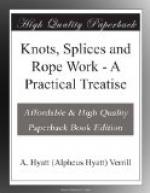[Illustration: FIG. 89.—Seizing a selvagee strap.]
[Illustration: FIG. 90 A.—Making Flemish eye.]
[Illustration: FIG. 90 B.—Flemish eye (complete).]
[Illustration: FIG. 91.—Artificial eye.]
Take the end of a rope and unlay one strand; place the two remaining strands back alongside of the standing part (Fig. 92). Pass the loose strand which has been unlaid over the end, and follow around the spaces between the two strands and then around eye,—as in making a grommet,—until it returns down the standing part and lies under the eye with the strands (Fig. 93). Then divide the strands, taper them down, and whip the whole with yarn or marline (Fig. 94).
[Illustration: FIGS. 92 and 93.—Making artificial eye.]
[Illustration: FIG. 94.—Artificial eye (whipped).]
Still another eye which at times will be useful is the “Throat Seizing,” shown in Fig. 95. This is made by opening the end slightly and lashing it to the standing part as shown. Another ring sometimes used is illustrated in Fig. 96, and is easily and quickly made by lashing the two ends of a short rope to the standing part of another. Cuckolds’ necks with lashings or “Clinches” are also used for the same purpose.
[Illustration: FIG. 95.—Throat seizing.]
[Illustration: FIG. 96.—Lashed cut-splice.]
CHAPTER VI
LASHINGS, SEIZINGS, SPLICES, ETC.
Almost any one can lash a rope more or less satisfactorily, but a knowledge of how to do this properly and in the manner best suited to each case is of great importance to seamen and others having occasion to handle ropes, rigging, or in fact any cordage.
The varieties of lashings, seizings, whippings, and servings are almost innumerable, but a few of the best and most frequently used are the “Wedding Knot” or “Rose Lashing,” the “Deadeye Lashing,” the “Belaying-pin Splice,” the “Necklace Tie,” the “Close Band,” and “End Pointings.” The rose lashing (Fig. 97) is used to join two eyes or ropes finished with loops. The deadeye lashing (Fig. 98) is frequently used on ships’ standing rigging and is a familiar sight to every one who has seen a sailing-vessel. It consists of a small line reeved back and forth through the holes in the “deadeyes,” A; the ends are then seized to the standing rigging to prevent slipping. This lashing admits of easy and rapid lengthening or shortening of the rigging and is particularly useful in connection with wire cable. A similar method may be used with loops instead of deadeyes (Fig. 99). The belaying-pin splice, shown in Fig. 100, is a quick and handy way of fastening two ropes together and is of great value when rigging is carried away and some quick method of joining the severed ends is required. Pass a belaying-pin or similar toggle through an eye or loop in one end of a rope and pass this through a loop or eye in the broken rope end. Form a loop in the other broken end, slip the free end of the lanyard through this and around another toggle or pin and haul taut; then fasten by half-hitches around standing part (A, Fig. 100), or by seizing (B, Fig. 100). This is a strong, reliable fastening and can be tightened up or instantly thrown off at will.




